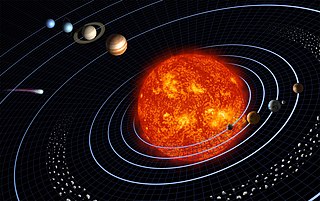Related Research Articles

Thebe, also known as Jupiter XIV, is the fourth of Jupiter's moons by distance from the planet. It was discovered by Stephen P. Synnott in images from the Voyager 1 space probe taken on March 5, 1979, while making its flyby of Jupiter. In 1983, it was officially named after the mythological nymph Thebe.

The timeline of discovery of Solar System planets and their natural satellites charts the progress of the discovery of new bodies over history. Each object is listed in chronological order of its discovery, identified through its various designations, and the discoverer(s) listed. Historically the naming of moons did not always match the times of their discovery. Traditionally, the discoverer enjoys the privilege of naming the new object; however, some neglected to do so or actively declined. The issue arose nearly as soon as planetary satellites were discovered: Galileo referred to the four main satellites of Jupiter using numbers while the names suggested by his rival Simon Marius gradually gained universal acceptance. The International Astronomical Union (IAU) eventually started officially approving names in the late 1970s.
In ancient times, only the Sun and Moon, a few stars, and the most easily visible planets had names. Over the last few hundred years, the number of identified astronomical objects has risen from hundreds to over a billion, and more are discovered every year. Astronomers need to be able to assign systematic designations to unambiguously identify all of these objects, and at the same time give names to the most interesting objects, and where relevant, features of those objects.
Peter Kušnirák is a Slovak astronomer, discoverer of minor planets, and a prolific photometrist of light-curves at Ondřejov Observatory in the Czech Republic. He was married to Slovak astronomer Ulrika Babiaková with whom he discovered 123647 Tomáško, named after their son Tomáško.
Pierre Antonini is a retired French mathematics professor and amateur astronomer who has discovered several minor planets and two supernovae at his private Observatoire de Bédoin located at Bédoin, southeastern France. For many of his discoveries he used a 16-cm telescope or a 30-cm telescope.
Giuseppe Forti was an Italian astronomer and a discoverer of asteroids.
Alan Charles Gilmore is a New Zealand astronomer and a discoverer of minor planets and other astronomical objects.
Marco Cavagna was an Italian amateur astronomer.

Farpoint Observatory is an astronomical observatory owned and operated by the Northeast Kansas Amateur Astronomers' League, or NEKAAL. It is located on the grounds of Mission Valley High School at Eskridge, near Auburn, Kansas, approximately 30 miles (48 km) southwest of Topeka, Kansas, United States.
Poul B. Jensen is a Danish astronomer and a discoverer of 98 minor planets while working at Brorfelde Observatory. Between 1967 and 1969 he assisted in positional observations with the observatory's 7" transit circle. He is also a co-discoverer of the Comet Jensen-Shoemaker (1987g1). As of 2004, he was still publishing in the Minor Planet Circulars.
1647 Menelaus is a mid-sized Jupiter trojan from the Greek camp, approximately 42 kilometers in diameter. It was discovered on 23 June 1957 by American astronomer Seth Nicholson at the Palomar Observatory in California, and later named after the Spartan King Menelaus from Greek mythology. The dark asteroid has a rotation period of 17.7 hours. It is the principal body of the proposed Menelaus cluster, which encompasses several, mostly tentative Jovian asteroid families.
2312 Duboshin, provisional designation 1976 GU2, is a dark Hildian asteroid from the outermost regions of the asteroid belt, approximately 54 kilometers (34 miles) in diameter. It was discovered on 1 April 1976, by Soviet–Russian astronomer Nikolai Chernykh at the Crimean Astrophysical Observatory in Nauchnij, on the Crimean peninsula. It was named after Russian astronomer Georgij Duboshin. The D-type asteroid has a longer than average rotation period of 50.78 hours.
4435 Holt, provisional designation 1983 AG2, is a stony asteroid, sizable Mars-crosser and binary system from the inner regions of the asteroid belt, approximately 5 kilometers in diameter. It was discovered on 13 January 1983, by American astronomer Carolyn Shoemaker at the Palomar Observatory in California, United States. It was later named after American astronomer Henry E. Holt. The discovery of its companion was announced in January 2018.
1851 Lacroute, provisional designation 1950 VA, is an asteroid from the outer region of the asteroid belt, approximately 17 kilometers in diameter.
Paul Herget was an American astronomer and director of the Cincinnati Observatory, who established the Minor Planet Center after World War II.
Walter Ferreri, originally from Buddusò in Sardinia, is an astronomer at the Italian Osservatorio Astronomico di Torino, science writer and discoverer of minor planets.
Thierry Pauwels is a Belgian astronomer from the Royal Observatory of Belgium. Between 1996 and 2008 he discovered and co-discovered 146 minor planets. This makes him one of the top 100 minor planet discoverers.
References
- 1 2 Schmadel, Lutz D. (2007). "(6154) Stevesynnott". Dictionary of Minor Planet Names – (6154) Stevesynnott. Springer Berlin Heidelberg. p. 513. doi:10.1007/978-3-540-29925-7_5682. ISBN 978-3-540-00238-3.
- ↑ "Stephen P. Synnott". IAU – International Astronomical Union. Retrieved 17 June 2017.
- ↑ Johnston, Robert (14 June 2017). "List of IAU Preliminary Designations of Natural Satellites". johnstonsarchive.net. Retrieved 16 June 2017.
- ↑ daviddarling.info; retrieved 29 August 2010
- ↑ "MPC/MPO/MPS Archive". Minor Planet Center. Retrieved 17 June 2017.